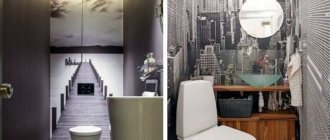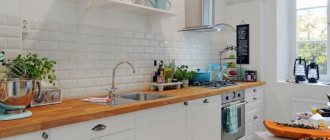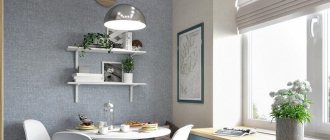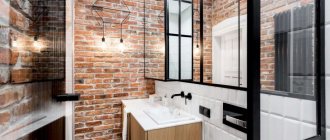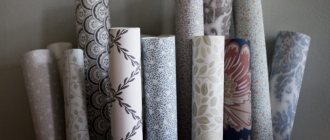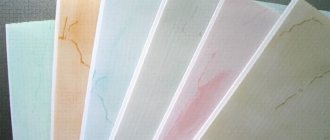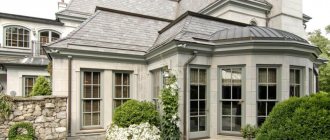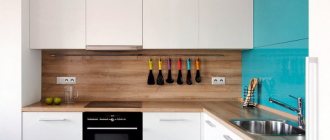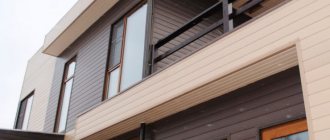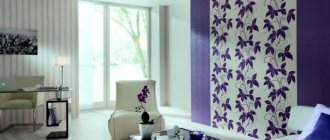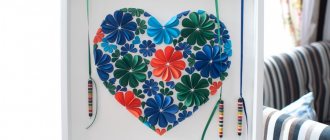12 options for a kitchen apron made from scrap materials are very affordable, easy and fast! They're all simple, cheap and can be made (or removed) in literally minutes, making them ideal for renters or anyone looking to change up their kitchen splashback.
So let’s look at what to make a kitchen apron from and what materials are used for installation.
- 1 Perforated panels
- 2 Apron made from photo frames
- 3 Apron made of paper or card
- 4 Vinyl oilcloth
- 5 Apron made of wood or MDF
- 6 6. Mosaic apron made from old dishes
- 7 Stainless steel
- 8 Stone apron
- 9 Traffic
- 10 Painting with stencils
- 11 Tile
Perforated panels
Such panels allow you to conveniently place the necessary kitchen utensils, hanging them in any place on the wall you choose.
- you need to attach the panels to the walls,
- and then insert hooks from the hardware store into the holes, and their location can be constantly changed depending on your needs.
Apron made of paper or card
Look how wonderfully an apron made from a glued-on world map combines with white kitchen furniture. A really easy way to make your kitchen original! How to do:
- Cut a thin piece of plywood to the exact size of the wall, glue paper on top,
- and then apply varnish (so that the paper does not get wet from moisture and steam in the kitchen).
- Once dry, attach the plywood to the wall.
They used cards here, but you could use wrapping paper, comic books, magazine covers, anything like that.
You can attach frequently used recipes to the kitchen wall , this will save you from having to look for them when needed, and will add an interesting touch to your kitchen design. You can also attach your favorite quotes or poems.
No. 10. Metal: ideal for high-tech style
A metal apron will fit only into a modern-style interior . There are many advantages to such a solution: durability, resistance to fire and water, and chemicals . At the same time, you will have to put up with the fact that all the splashes , drips, and stains are clearly visible on the metal. They will need to be wiped regularly to ensure the coating looks perfect, but this is not that difficult, especially since you can get rid of dirt quite quickly.
The main disadvantage of this finish is its cold appearance, and there are very few possible colors. It is important to think through the interior of the kitchen very well so that such an apron looks truly organic and stylish. Moreover, this material reflects light very well, so you need to think through the lighting system so as not to end up with a room with an abundance of glare and sunbeams.
Apron made of wood or MDF
Wood planks add a touch of rustic style. To make such an apron, you will need a thin piece of plywood exactly the size of the wall. All the boards are cut to the required length and attached to the plywood, and then the whole thing is screwed to the wall.
How to do it yourself:
- To create such an apron, wooden boards were painted white,
- and then cut into equal pieces (the size of tiles).
- After this, all the “tiles” are attached to a thin piece of plywood that is the size of the wall, and then the plywood is attached to the wall.
How to paint boards in an unusual way - a detailed lesson
Boards can be laid out to create different geometric shapes. For example, here is a zigzag made of boards painted white. Of course, in this case, you need to clearly mark the wall so that all the pieces fit together well.
And one more example of using boards. Here we took ordinary untreated wooden boards, attached them horizontally to the wall, and this is what came out of it!
How to age wood - a detailed master class
Sizing
Drawing up a diagram for an apron
- The size and shape of the apron is determined by the kitchen set - the apron should cover the visible space of the wall.
- To install an apron in the kitchen with your own hands, we will draw its diagram and determine the dimensions.
- The distance from the floor to the base of the apron is determined by the height of the tables (standard - 85 cm), which corresponds to the height of the stove.
- If a washing machine is installed in the kitchen, then we will increase the height to 90 cm, and we will make a stand under the stove.
- The apron should be at least 1 cm below the table tops.
Height from floor
Advice! When marking the beginning of the apron by level, it is worth checking this distance at different points in the kitchen so that, due to the curvature of the floor, the beginning of the apron does not end up above the countertop.
Apron height
The distance from the tables to the wall cabinets is the height of the apron. As a rule, this is 55-65 cm. The optimal one is 60 cm: it’s even convenient to choose tiles for it.
But the exact height measurement is not required, because the cabinets can hang over the apron.
Apron under the hood
It is more difficult to finish the apron in the kitchen under the hood.
- The height of the hood apron is at least 70-75 cm, and the maximum depends on the design of the hood.
- A kitchen hood without a cabinet above it involves installing an apron up to the height of the kitchen cabinets.
- For a hood with a pull-out panel or a cabinet, you need an apron 75 cm high.
- The width of the apron under the hood depends on its width - 50, 60, 90 cm. It is advisable for the apron to extend at least 5 cm under each side of the hood.
Advice! Setting the apron 5-10 cm under countertops and cabinets is necessary, since the furniture is likely to move slightly from its design position during installation.
Electrical sockets
The installation of a kitchen apron is always accompanied by the installation of sockets. We install them above the work surface: for the stove, hood, washing machine, dishwasher, refrigerator, lighting, that is, 3-5 and can be a block.
Mosaic apron made from old dishes
Broken dishes are a kind of homemade tiles. Laying a kitchen apron and the result are similar, only you don’t need to buy the material, because it is used for dishes that you haven’t used for a long time and have finally found a new use.
And one more option for using this method, and here the result is similar to a painting of modern art. Beautiful and impressive!
How to make a mosaic yourself - watch the master class
Stone apron
A kitchen apron made of stone will help create a rustic style and will be a wonderful addition to the interior.
Do you constantly collect pebbles on the beach? Or maybe there are a lot of them in your garden? Then look at one of the options for using them. It looks like mosaic masonry, beautiful and original!
Dye
The most ancient version of kitchen design will help to decorate the room in a familiar or unusual way.
Dye:
- Feels great in any climate change;
- Retains its attractiveness for a long time;
- Does not require hassle or worries.
If desired, a flat surface can be decorated with patterns or stickers, creating the most unique design. The material is perfect for any design style and any area.
Painting with stencils
Painting is a quick and easy way to update a kitchen wall. You can paint it in one or more colors. The last option is convenient and easy to implement using stencils. With their help, you can make a beautiful pattern or inscription, creating your own style.
For example, here the wall was painted black, and then the inscription was applied in white using a stencil.
You can also create geometric patterns. Moreover, in this case, you can make the stencil yourself using masking tape.
Master class on how to make patterns and drawings on the walls
And another option for stencil painting:
Also, painted walls can be decorated with additional decorative elements. For example, this kitchen apron was painted using stencils, and then hearts were glued on top, which go wonderfully with the chosen pattern:
Love the tile pattern but don't want to bother laying the tile? Then try options to imitate it. For example, here is a wonderful example of painted white tiles. All you need is paint and precise markings of the wall.
Features of wall decor in the kitchen
The room cannot boast of a good microclimate. Here the temperature can rise or fall sharply, humidity increase, juice begins to splash or fat begins to fly.
Therefore, the wall decoration should be ready:
- Withstand changes in temperature and humidity;
- Does not require complex maintenance, especially in the work area;
- Do not absorb odors and fat;
- Do not become a breeding ground for bacteria.
It should also complement the existing interior and please the owners.
Tile
Create a mosaic backsplash with your own design using small tiles in different colors. For example, in this case, dark brown floor tiles were needed.
You can also create a mosaic pattern by breaking large tiles into smaller pieces before attaching them to the wall. The result is similar to the previous one, but more chaotic, without clear lines.
If you like more formal shapes and colors, then pay attention to this combination of small tiles in white, brown and gray:
When using very small tiles, it seems that the colors transform into each other and shimmer. In the example in the photo, a dark color scheme was chosen, but with such tiles you can experiment with even the brightest colors.
The shape of the tile has a great influence on the result, for example, taking a hexagonal tile instead of a square one immediately achieves an original effect. It is especially good to take hexagonal tiles, which have some color transitions, like here from white to gray:
Using tiles you can achieve a 3D effect. To do this, lay the tiles not side by side at the joint, but overlapping each other, creating volume. For example, like in this case:
Materials
Many materials used for countertops are also used in the production of backsplashes. This is due to their good performance.
Ceramic tile
Small squares or rectangles (other shapes are less common) are one of the most popular varieties, which is not surprising, because glazed ceramics have been used for a long time and have an impressive range of advantages.
- It practically does not absorb moisture, which means it does not collapse and does not allow pathogenic microflora to develop.
- Does not absorb dyes, grease, washes well and is not afraid of chemicals (except for hydrofluoric acid).
- Fireproof, does not react to steam and there are no harmful fumes from it.
- Durable, does not scratch and is damaged only by strong targeted impacts.
- The decorative possibilities of such products are practically unlimited: tiles differ in color, size and texture. It is allowed to change the layout scheme, combine different shades and create interesting patterns.
This option also has disadvantages.
- In order to get a beautiful result, the wall must be flat.
- Laying tile cladding is a rather labor-intensive process that requires a certain amount of skill.
- The main disadvantage is the presence of seams. No matter what grout is used, dirt gradually accumulates in the seams and they darken. It will not be possible to wash them to pristine cleanliness.
Focusing only on beauty and forgetting about the practical side is not very smart. The following tips will help you find a compromise:
- it is better to choose samples without a chamfer: less dirt will accumulate in the seams;
- a relief pattern will add work to clean dirt from the recesses;
- a very light gloss can also hardly be called practical due to the fact that the smallest specks are visible on it;
Although, on the other hand, such soiling forces the housewife to always maintain perfect order, which is also not bad.
- optimal choice: colored tiles with dark grout. And it looks very beautiful, attracting the eye, and the stains are almost invisible.
The price of such items varies greatly, much depends on the quality and manufacturer. You can find budget models from domestic brands and luxury items from well-known foreign companies.
Mosaic
Miniature squares of 5x5 or 7x7 cm. Ceramic tiles, mirrors, glass or metal are used to produce mosaics.
From the point of view of ease of installation, this cladding is one of the most complex, takes a long time and requires a significant level of professionalism and filigree precision.
To facilitate this process, many manufacturers attach the mosaic to a flexible fiberglass mesh. It is much easier to work with such products. The surface does not need a perfectly flat wall: it will hide minor flaws well.
Another disadvantage is the presence of even more seams, which means that it will take a wagon and a small cart to maintain a decent appearance. Other performance properties depend on the specific type of material from which the panel elements are made.
But from miniature pieces you can create ornate patterns and complex ornaments that other finishes cannot replicate.
Natural and artificial stone
This type of cladding is often done to support the countertop. It looks very solid and solid. But all breeds have one feature: heaviness, so serious work has to be done during installation.
The category of artificial stone includes acrylic, porcelain stoneware and quartz agglomerate.
- Acrylic
It is a mixture of composite chips, pigment and acrylic resin. The composition of this raw material is closer to plastic, so you should be careful when using it. It is capable of absorbing coloring pigments, but is scratched and deteriorated by contact with heat.
But it is acrylic that provides the widest possibilities for choosing a design. Production technology helps create seamless objects of the most unimaginable shapes. In addition, if damaged, such a sample can be sanded and restored several times. It is relatively inexpensive, and the finish will always be like new.
- Porcelain tiles
It consists of clay powder, quartz sand, feldspar and other components, which are combined into a monolith using semi-dry pressing at a temperature of 1300 degrees Celsius.
It has low moisture absorption, is not afraid of high temperatures and chemicals, and is very durable. The only disappointment is the relatively small palette of colors.
- Quartz agglomerate
Made from quartz chips and polyester resins. Quartz is very durable and transfers its qualities to the agglomerate. This material is resistant to liquids, heat and chemicals. It serves for many years, and does not mind mechanical damage.
However, if in some unimaginable way you managed to damage the agglomerate, then it cannot be restored. You cannot use abrasives to clean it, and you also need to be prepared for the fact that the cladding becomes dull from sunlight.
In Russia there is a limited number of color solutions. This happens because such a basis is relatively new to us, and not everyone even knows about its existence and positive features. And the price scares away potential consumers. Although cost is a minus of all stone aprons, regardless of whether they are natural or artificial.
Among natural stones, granite, marble or onyx are most often used for kitchens.
Granite has excellent characteristics: it is easy to clean, tolerates moisture well, and is fire-resistant. However, not everyone likes the limited color range.
Marble is much nicer in this sense. It looks more impressive than if the surface is finished with granite, but in other respects it is inferior to its fellow: it absorbs water and dirt, which is why it gradually deteriorates, turns yellow from heat and does not like household chemicals. This capricious stone requires periodic impregnation with special substances, otherwise it quickly loses its attractiveness.
The above is quite true for onyx. Onyx looks amazing when backlit. Look at the photo, isn't it impressive? I just fell in love.
Natural stones require increased attention in terms of checking their safety. Some may have increased background radiation, so be sure to check the documentation. Those who are especially worried can take a Geiger counter with them and check the radiation readings of the selected raw materials on the spot.
But pathogenic organisms do not live on a stone base, therefore, from this point of view, natural stone is safe (although artificial stone has a similar property).
The stones are not particularly impact resistant and cannot be repaired if damaged.
Tree
Such objects look beautiful, especially suitable for a white or black kitchen, but they can hardly be called practical, since wood products are afraid of fire and humidity. They can rot, crack, and darken. And although hardwood is used for aprons, the risk of unpleasant phenomena is very high.
Although this largely depends on the manufacturer and how he processes the wood. If it is impregnated with high-quality protective compounds and varnished, it will last a long time.
It is also necessary to take into account that such a model cannot be installed behind the stove due to the risk of fire, and it is undesirable to install it near the sink, as this increases the likelihood of rapid damage.
Such a surface is scratched, and dents form on it due to careless handling, so care should be taken when using it. For cleaning, it is advisable to use a simple sponge or soft cloth and a mild soap solution. Under no circumstances should you rub the wood with hard sponges, powders, or apply aggressive chemicals to it.
Stainless steel
For finishing, use whole sheets of stainless steel or small pieces in the form of tiles or mosaics.
Steel has good user characteristics: it is not afraid of water, can be easily cleaned, is absolutely safe, and bacteria do not live on it. It is because of these characteristics that such work surfaces are installed in catering establishments, hospitals, schools and other institutions.
The smallest drops and stains are clearly visible on the metal, and it is very difficult to wipe them off without streaks. You'll probably have to suffer. It is better to choose matte stainless steel; in this sense, it is a little more practical.
Be sure to protect the object from acids, otherwise dark, unsightly spots may remain.
Despite the excellent parameters, such models are not widespread. This is explained by the fact that such an apron fits into a very small number of concepts. High-tech and, in some cases, minimalism are ideal for it. Sometimes they create a combination of steel and wood: the stove and sink area is finished with stainless steel, and the rest with wood.
Glass
In another way, such panels are called skinali. It’s worth saying right away that tempered impact-resistant glass is used, which is very resistant to damage, unlike regular glass.
This option is very popular, and its popularity is only growing due to a number of positive qualities:
- not afraid of high temperatures and water;
- the smooth surface is easy to clean, in addition, it is allowed to use powdered products;
- There are a huge number of designs offered that can be selected for any chosen kitchen: matte or colored, with sandblasted patterns, with a mirror, corrugated, with photo printing.
You may be offered inexpensive panels made of ordinary glass. They are usually installed as protective screens on wallpaper or other wall coverings. I’ll say right away that judging by the reviews, this is not the best choice, since such glass will almost certainly crack from temperature changes or an accidental impact, and it’s good if it doesn’t shatter into many small fragments. In addition, during installation it is necessary to provide complete waterproofing of the joints of the parts, otherwise water will penetrate under the glass and ruin the coating.
Such a solution requires special accuracy when taking measurements, because it is impossible to cut off the excess on the spot, and if the apron is smaller, then nothing can be corrected by any means. Difficulties also arise with sockets: for each of them, a hole must be drilled in the workshop. And most likely, you will have to pay extra for them. This is a plus to the fact that they also cost a lot of money.
I think it’s clear that it’s difficult to install such models yourself. It is better to attract reliable specialists.
Plastic
This group of materials is distinguished by an enviable diversity. Different types of plastic behave completely differently in daily use, differ in service life and other parameters.
- HPL and CPL plastic
Products are made from such plastic using postforming technology (rounding of edges). It is very easy to install: there is no need for special surface preparation, it bends and fits well.
It has acceptable consumer properties, but they are significantly worse than those of ceramics, acrylic, stone or glass. It is important here that the joints are carefully insulated, otherwise the base will deteriorate. You also need to be more careful with colored pigments, which can eat into the finish.
It tolerates treatment well with all detergents, with the exception of abrasives.
But the decorative possibilities for cladding are endless: you can order any color and pattern.
- PVC
It comes in the form of sheets or lining. It does not require necessarily leveling the walls, because it is quite flexible. Other advantages include moisture resistance and a large selection of designs.
Of the minuses: it is susceptible to mechanical damage, deformed from heat, the design fades and wears off, turns yellow, mold may appear in the space between the panel and the wall (especially near the sink).
You're probably asking how such an imperfect material made it onto our list? The answer is simple: PVC plastic is cheap, and therefore finds its buyer, even despite multiple flaws.
- ABS
May have an acrylic or polycarbonate base. The second is more practical because it is resistant to temperature changes.
These aprons are lightweight, flexible, resistant to damage and household chemicals. Simple installation and a variety of design solutions are also considered a plus.
Chipboard
Chipboard is wood shavings and sawdust glued together with resins. Cheap gluing products use compounds containing formaldehyde, which evaporates into the air and negatively affects human health.
Chipboard is very afraid of water; if it gets on it, the board swells and swollen areas appear. It is impossible to get rid of them; you will either have to put up with it or change the lining. Therefore, the first condition for such materials is a carefully processed and closed edge.
MDF
MDF is chips compressed under high temperature and pressure. No toxic components are used in production, and this base is safe. The created multilayer structure allows you to obtain a smooth surface that is easy to care for.
MDF also does not like water, but it is denser than chipboard, and for it to swell, contact with moisture must be prolonged. But the requirements for careful sealing of the edge are also relevant for this material.
You should also take extra care when installing such a screen near the stove and make sure that it does not get too hot.
The base is durable, easy to install, you can even do it without the involvement of specialists. Finding the right color shade for any room style is not difficult.
The video will tell you how to decorate a kitchen apron.
Other options
We looked at the most common finishing options. However, the imagination of designers and folk craftsmen is truly inexhaustible. Nowadays, a non-standard approach and unexpected solutions are relevant. For example:
- polished pebbles embedded in concrete or cement;
- wine corks hidden under glass;
- decorative plaster;
- high-moisture resistance laminate treated with wax;
- brick or clinker tiles (imitation brickwork).
These finishes can be quite expensive and many of them are impractical to maintain, so think carefully about whether you need it. Especially when there are proven ways to decorate the kitchen.
